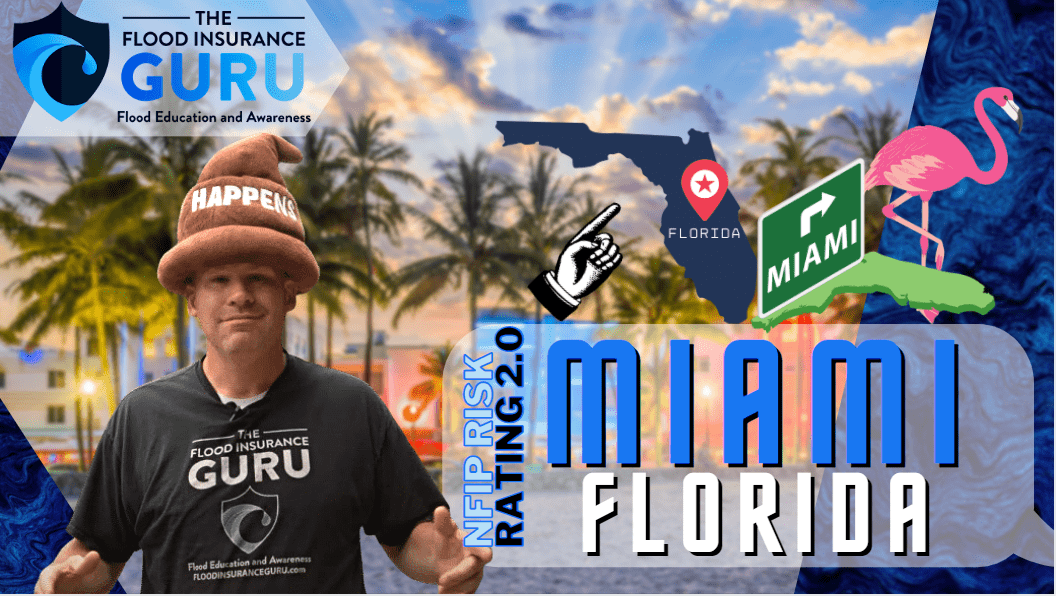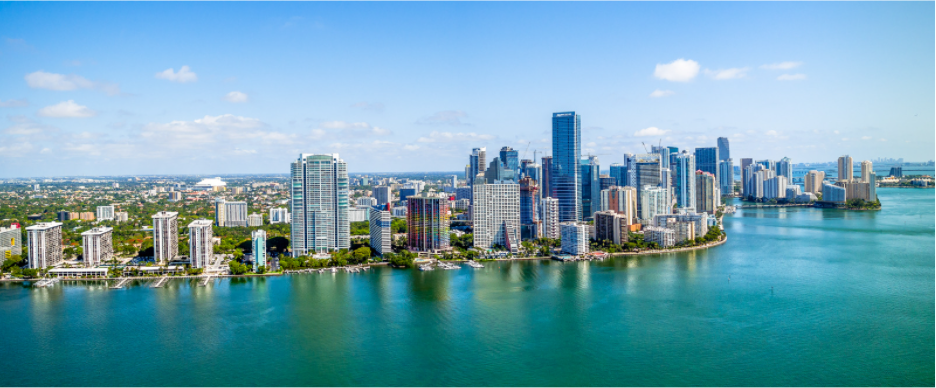
Today, we dive deeper into more specific territories and discuss the changes coming with the National Flood Insurance Program (NFIP) Risk Rating 2.0 to Miami City in Miami-Dade County, Florida.
It's no secret that the coastal city of Miami has been had its fair share of floods throughout history. The state as a whole itself is no stranger to different types of floods. You have these floods that come from the coast, one that's collected throughout a long period during a storm, and runoff from higher places.

So today, we want to discuss how the new Risk Rating 2.0 will impact your flood insurance policy with the Federal Emergency Management Agency (FEMA) and see if these changes to flood insurance premium gives the federal flood insurance to the more popular private sector which offers replacement cost.
If you want to read more on the Florida Risk Rating 2.0 update, click here!
Risk Rating 2.0: What Changes?
This is what FEMA calls equity in action when it comes to making the cost of flood insurance policies fairer per policyholder. This simply means that when it comes to flood insurance rates, a lot of things will start to change with the NFIP and FEMA. Generally, this is because property values for each individual property will be accounted for when finalizing your quote and flood insurance premiums with the National Flood Insurance Program (NFIP). In turn, the NFIP and FEMA make sure that you will get accurate flood insurance rates for your policy.

It's important to note, however, that this won't mean that the cheapest flood insurance will go automatically to lower-valued homes, and higher-valued homes or expensive properties will cause a big headache for the property owner. It's equally important that we take into account, just like FEMA does and the private flood insurance industry, what's called flood risk variables. There are things that are staying and changing when it comes to calculating your flood risk score.
The remaining features are as follows:
- Zone designation in the flood maps (e.g. Flood Zone AE, Flood Zone V, Flood Zone X)
- Distance to a body of water such as a river, lake, or even the coastline
- Prior flood insurance claims or flood claims made with the property
- Policy assumption and grandfather rule
The new things that will come with the Risk Rating 2.0 are as follows:
- Types of floods that your property experience. This can be either pluvial or the accumulated water due to heavy rainfall, runoff of collected water that flows from higher areas, storm surge and coastal erosion, dam/levee damage or overflow, and even a combination of these things.
- First-floor height and elevation of the structure. A new feature that determines your flood risk score is the distance between the ground (grade) from your first floor or the first habitable floor of your property.
- Flood Risk Mitigation Measures made on the property. Is the lowest floor above the base flood elevation? Are there enough flood openings to let floodwaters through?
Now that we've covered the NFIP and the Risk Rating 2.0, let's talk about its impact on Miami. We'll cover the good, the bad, and the ugly changes coming to the residents of the city.

The Good
When we're talking about these changes, we want to emphasize that this will solely involve flood premiums changes or updates from FEMA and the NFIP. Let's kick this off with the good changes coming to residents of Miami.
The good changes will involve an immediate decrease in flood premiums with FEMA. This decrease can go up to more than $100 (>$1200 per year) and will impact 22.2% or 77,092 NFIP-insured properties in the city. We divide these changes into two parts.
The first covers the decrease in flood insurance rates or premiums that ranges from $0 to $50 per month (up to $600 per year). About 70,074 or 20.2% of the policies will be impacted by this change.
On the other hand, you have a better deal with the second part of this good change since it generally covers a 7,018 or 2% of the national flood insurance policies in force. The immediate decrease ranges from $50 to more than $100 per month ($600 - >$1200 per year).
Considering that the national average when it comes to premiums is about $1000 across the United States, this can really help a lot of people get flood insurance through FEMA especially when we're talking about coastal zones where flood risks can be extremely high and get the bulk of the damages from natural disasters.
The Bad
If there are good changes, there are also bad ones. This change from the Risk Rating 2.0 will get increase your flood insurance costs when it comes to FEMA and the National Flood Insurance Program (NFIP).
The increase will range from $0 to $10 per month (up to $120 per year) and will impact about 246,303 or 71.1% of the policies in the city itself. Now, this increase may seem so small, but you have to consider that this takes the biggest percent out of the population in Miami.
Now that we're facing increased climate risks, it's hard to ignore that the risk of flooding in areas that sit near the coastline is safe from the damage from floods.
The Ugly
Now, let's move deeper and into the ugly changes. For this part, we want to emphasize that we divided this into three parts: the ugly, the uglier, and the ugliest change. Let's dive into specifics.
First, the ugly change will be covering about 13,797 or 4% of the policies. The reason why this falls under the ugly change is that the increase is now noticeable since it ranges from $10 to $20 per month ($120 to $240 per year).
On the other hand, you have the uglier change which is something that about 8,461 or 2.4% will experience. This time around, the increase won't be bearable since it ranges from $20 to $50 per month ($240 to $600 per year).
Lastly, you can also see few Miami residents fall on the ugliest side. This mostly involves about 1,015 or 0.5% of properties in the city. Although it's a very small number of people, you have to realize that the increase ranges from $50 to more than $100 per month ($600 to >$1200 per year in annual premium).
This can really make it difficult to go into federal flood insurance and even a harder experience if the private flood insurance market is not available to protect you from floodwaters. Regardless of where you fall on these three, considering that the average premium across Florida is about $600, this type of increase can really hurt your budget and we won't even blame you if you want to get private policies.

The National Flood Insurance Program
The National Flood Insurance Program (NFIP) is the answer of the federal government when it comes to flood concerns. This program was established ever since 1968 through the National Flood Insurance Act of 1968. The NFIP is currently working as the federal or government agencies' flood insurance for the United States and its residents. FEMA and NFIP always look into analyzing and studying floodplain devolvement, flood model management, flood insurance, and disaster assistance. So, what does the NFIP cover?
First, it's important to keep in mind that flood insurance is a separate policy from your usual homeowner's insurance and auto insurance policies. This means that if your house gets inundated during a flood event, it won't be the homeowner's policy that will give you flood coverage.
Now that we got that out of the way, the National Flood Insurance Program (NFIP) provides coverages for the flood damage that your property will sustain. The property will involve both the dwelling or the building itself — either residential property or commercial — as well as the contents or the personal property that's inside the insured home. NFIP flood insurance will provide coverage for the dwelling that maxes to $250,000 and contents that maxes to $100,000. There's also additional coverage that comes in when you're a participating community in the National Flood Insurance Program (NFIP) which can be enjoyed through the Community Rating System (CRS) and the Increased Cost of Compliance (ICC).
When Will It Happen?
The Risk Rating 2.0 from the National Flood Insurance Program (NFIP) will take effect starting this October 1st, 2021. It's important to note however that you really don't need to immediately adopt these new rates once Fall comes. The NFIP will allow you to adopt these new rates on your renewal, so if you just renewed your policy with FEMA last April then you can move into the new rates in April 2022.
At the end of the day, we're still subject to extreme weather events, and our friends in coastal areas are more prone to the dangers of these disasters. It's best to know where to get a policy best because we've seen that even without floods, a lot of people still drown due to these expensive insurance premiums.
If you have questions on your flood insurance options in Florida, your flood risk score, or anything about flood, reach out to us by clicking below. Remember, we have an educational background in flood mitigation which lets us help you understand flood risks, your flood insurance, and mitigating your property long-term.
-rgb-300px-w-300ppi.png?width=350&height=124&name=tfig-logo-inverted-(for-dark-backgrounds)-rgb-300px-w-300ppi.png)
-rgb-300px-w-300ppi.png?width=301&height=107&name=tfig-logo-inverted-(for-dark-backgrounds)-rgb-300px-w-300ppi.png)
